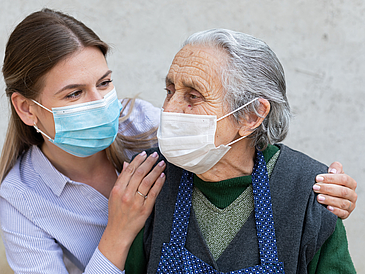“It is not only people in need of care who are at particular risk of severe disease progression and high mortality when infected with SARS-CoV2,” says Karin Wolf-Ostermann, professor of nursing science, who headed the study. It is also those providing the care that are also at a higher risk of infection. Care providers are often not able to provide the vital services while adhering to all the general protective measures.
What are the conditions in which care is currently provided in the domestic environment and in inpatient facilities, and what are the consequences of the pandemic there? A research group led by nursing professor Karin Wolf-Ostermann from the Institute for Public Health and Nursing Research and health economist Professor Heinz Rothgang from the SOCIUM Research Center on Inequality and Social Policy, together with a team of seven people, started to investigate the situation. They conducted a nationwide online survey in outpatient and inpatient nursing facilities. Survey data from 824 nursing homes, 701 nursing services, and 96 day-care facilities were analyzed.
Patients and Carers Often Affected by COVID-19
According to the study, there are strong effects on people in need of care in both, domestic and inpatient care, settings. “If the results of the survey are extrapolated to all of Germany, it becomes apparent that around 60 percent of all deceased persons are persons in need of care looked after by nursing homes or care services, whereby their share of all infected persons is only 8.5 percent in total. Nursing homes are therefore the most important place in relation to people who have died with COVID-19. This is where half of all deaths occur, although only just under one percent of the population lives in this type of housing. The mortality among people in need of care is thus more than fifty times higher than in the rest of the population,” says Professor Heinz Rothgang.
High infection rates were also observed for nursing staff. According to the authors of the study, the proportion of infected employees in outpatient care services is twice as high as in the standard population, and in inpatient facilities even six times as high. Nevertheless, three-fifths of nursing services and three-quarters of nursing homes have not recorded a COVID-19 case yet. This shows that protective measures have so far been successful. However, where the first infection occurs, the consequences are quickly severe. For this reason, the introduction of first infections must be consistently avoided and protection concepts must prevent the spread of infection among patients and employees.
Rapid Testing and Protective Materials Are not Sufficiently Available
The fact that it is possible to contain the infection is shown by the infections of staff and patients: More than half of the facilities with infected staff have no infected clients or residents. However, the authors emphasize that key measures need to be taken like rapid test results to identify potential sources of infection and sufficient protective materials to prevent transmission. Although the initial lack of supply of protective materials has decreased, one in four nursing services and one in six inpatient facilities still report bottlenecks in this respect. In addition, tests are still difficult to access in some cases. “The results are only transmitted after three to four days – too late to fully develop their potential as part of an effective protection concept,” says Karin Wolf-Ostermann. Therefore, serial testing is required where results are available more quickly.
Precarious Care Arrangements Endanger Stable Health Care Provision
With regard to quantitative care, almost half of all nursing services report significant changes resulting from the fact that services are no longer used by those in need of care and that day-care inpatient services or domestic care staff no longer available. As a result, four out of ten care services suffer from economic repercussions and, at the same time, the provision of care for those in need of it is endangered, unstable, or might not happen at all. There is an urgent need for support here, which is necessary to stabilize the often extremely fragile private care arrangements and thus to ensure adequate domestic care.
A Permanent Protective Concept Needed in Care
The long-term care provided by outpatient care services and inpatient facilities must be given more attention – also in view of a possible second wave of the pandemic – according to the conclusion of Professor Wolf-Ostermann and Professor Rothgang. If the focus of politics and the public in the medical and nursing sector is currently directed primarily at the capacities of clinical and intensive medical care for acutely infected persons, the long-term care of the most endangered population group will become increasingly precarious. While hotspots of the disease can develop very quickly in inpatient long-term care facilities because many very elderly and multi-morbid people live in a confined space, outpatient care situations are destabilized. This would jeopardize the daily care of those in need of care.
Conclusion
Against this background, the Bremen researchers conclude: In order to be able to guarantee stable health care provisions beyond the acute pandemic situation, the demands of nursing services and inpatient facilities must be met. This includes nationwide and feasible recommendations for action, a permanent adequate supply of protective gear and disinfectant agents, systematic and regular testing of clients and staff, as well as better remuneration of nursing staff and better staffing.
Contact:
Prof. Dr. Karin Wolf-Ostermann
Department of Health Care Research at the Institute of Public Health and Nursing Research (IPP)
University of Bremen
Phone: +49 421 218-68960
Email: wolf-ostermann@uni-bremen.de
Prof. Dr. Heinz Rothgang
SOCIUM – Research Center on Inequality and Social Policy
University of Bremen
Phone: +49 421 218-58557
Email: rothgang@uni-bremen.de

